KSEEB Class 10 SSLC Biology Chapter 4 Heredity And Evolution
A recognisable feature of a human being (or any other organism) like height, complexion, shape of hair, colour of eyes, and shape of nose and chin, etc, are called ‘characters’ or ‘traits’. The transmission of characters (or traits) from the parents to their offsprings is called heredity. In most simple terms, heredity means continuity of features from one generation to the next.
Two parents, a male and a female, are involved in sexual reproduction. The sexually reproducing organisms produce sex cells or gametes. The male gamete called sperm fuses with a female gamete called ovum (or egg) to form a zygote which gradually develops into a young one (or offspring), showing some

similarities with the parents. Actually, the hereditary information is present in the sex cells (or gametes) of the parents. Thus, gametes constitute the link between one generation and the next, and pass on the paternal (father’s) and maternal (mother’s) characters or traits to the offspring. This relation that continues to exist between successive generations is referred to as heredity.
Variations Although the offsprings inherit the characters (or traits) of the parents and resemble them very closelybut the resemblance is not complete in all respects. The offsprings are never a true copy of the parents. In fact, no two individuals are exactly alike and the members of any one species differ from one another in some characters (or traits) or the other. These differences are known as variations. So, from the biological point of view, variation is the occurrence of differences among the individuals of a species.
“KSEEB Class 10 Biology Heredity and Evolution notes”
For example, people have different heights. Their complexion, type of hair, colour of eyes, shape of nose and shape of chin also show differences. The differences in the characters (or traits) among the individuals of a species is called variation. For example, human height a trait which shows variation. This is because some people are very tall, some are less tall, some have medium height, some have short height whereas others are very short.

Here is another example of variations in human beings which involves our ears. The lowest part of our ear is called earlobe. In most of the people, the earlobe is ‘hanging’ and it is called free earlobe In some people, however, the earlobe is closely attached to the side of the head and it is called attached earlobe.
Thus, most people have free earlobes whereas some people have attached earlobes. So, the free earlobes and attached earlobes are the two variations found in human population. Some amount of variations is produced even during asexual reproduction but it is very small. The number of variations produced during sexual reproduction .
 however, very large. For example, the sugar cane plants reproduce by the process of asexual reproduction, so if we observe a field of sugar cane, we will find very little variations in various sugar cane plants. All the sugar cane plants almost look alike. But in animals (including human beings) which reproduce by the process of sexual reproduction, a large number of variations are produced. It is due to these variations that no two human beings look alike (except identical twins).
however, very large. For example, the sugar cane plants reproduce by the process of asexual reproduction, so if we observe a field of sugar cane, we will find very little variations in various sugar cane plants. All the sugar cane plants almost look alike. But in animals (including human beings) which reproduce by the process of sexual reproduction, a large number of variations are produced. It is due to these variations that no two human beings look alike (except identical twins).
From this discussion we conclude that the number of successful variations is maximised by the process of sexual reproduction. The reproduction of organisms produces variations. The variations produced in organisms during successive generations get accumulated in the organisms. The significance of a variation shows up only if it continues to be inherited by the offspring for several generations. This will become clear from the following example.
Suppose a bacterium produces two bacteria by asexual reproduction. Again suppose that one of the offspring bacterium has a variation due to which it can tolerate a little higher temperature (or little more heat) than the other one. Now, this variation of little more heat resistance will go on accumulating in the offsprings of successive generations of this bacterium. And this will ultimately give rise to a variant of bacteria which will be highly heat resistant and able to survive even at very high temperatures.
The great advantage of variation to a species is that it increases the chances of its survival in a changing environment. For example, the accumulation of ‘heat resistant’ variation (or trait) in some bacteria will ensure its survival even when the temperature in its environment rises too much due to a heat wave or some other reasons. On the other hand, the bacteria which did not have this variation to withstand heat would not survive under these circumstances and die.
“SSLC Biology Chapter 4 Heredity and Evolution explained”
Before we describe Mendel’s experiments for explaining the transmission of characteristics (or traits) from parents to their offsprings or progeny, we should know the meaning of some terms such as chromosome, gene, dominant gene, recessive gene, genotype, phenotype, F₁ generation and F₂ generation. These are described on the next page. Chromosome is a thread-like structure in the nucleus of a cell formed of DNA which carries the genes.
Different organisms have different number of chromosomes in their nuclei. A gene is a unit of DNA on a chromosome which governs the synthesis of one protein that controls a specific characteristic (or trait) of an organism). There are thousands of genes on a chromosome which control various characteristics of an organism. Genes are actually units of heredity which transfer characteristics (or traits) from parents to their offsprings during reproduction. Genes work in pairs.
In diagrams and in explanations of heredity, genes are represented by letters. Genes controlling the same characteristics are given the same letters. For example, the gene for tallness is represented by the letter T whereas the gene for dwarfness is represented by the letter t. The letters T and t actually represent two forms of the same gene (which controls the length of an organism, say the length of stem of a plant).
Please note that genes had not been discovered at the time when Mendel conducted his experiments on pea plants to study the inheritance of characteristics. The term ‘factors’ which were used by Mendel as carriers of heredity information are now known as ‘genes’.
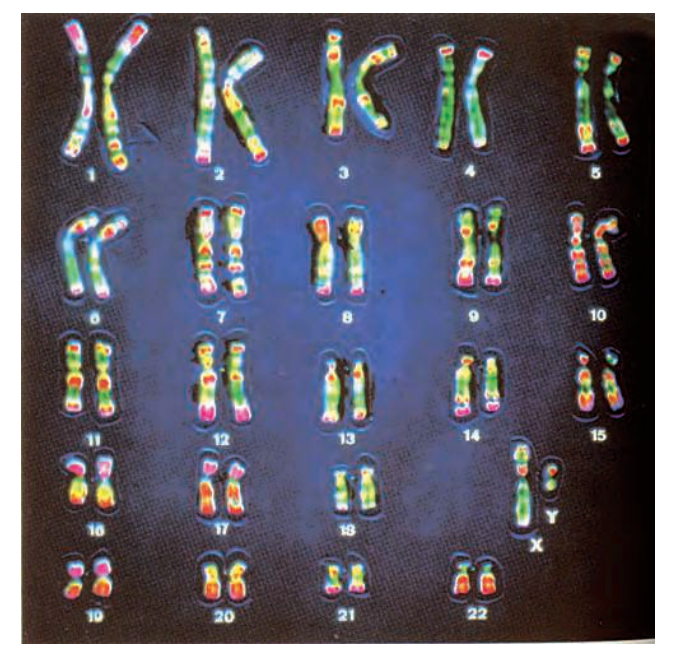

Genes for controlling the same characteristic of an organism can be of two types : dominant or recessive. The gene which decides the appearance of an organism even in the presence of an alternative gene is known as a dominant gene. It dominates the recessive gene for the same characteristic on the other chromosome of the pair. The gene which can decide the appearance of an organism only in the presence of another identical gene is called a recessive gene.
A single recessive gene cannot decide the appearance of an organism. The dominant gene is represented by a capital letter and the corresponding recessive gene is represented by the corresponding small letter. For example, in pea plants, the dominant gene for tallness is T and the recessive gene for dwartfness is it.
Thus, when we write the genetic cross for pea plant, then the capital ‘T’ represents ‘tall’ and small ‘t’ represents ‘dwarf’. Genotype shows the genetic constitution of an organism. In simple words, genotype is the description of genes present in an organism. Genotype is always a pair of letters such as TT, Tt or tt (where T and t are the different forms of the same gene). Thus, the genotype of a tall plant could be TT or Tt whereas that of a dwarf plant is tt.
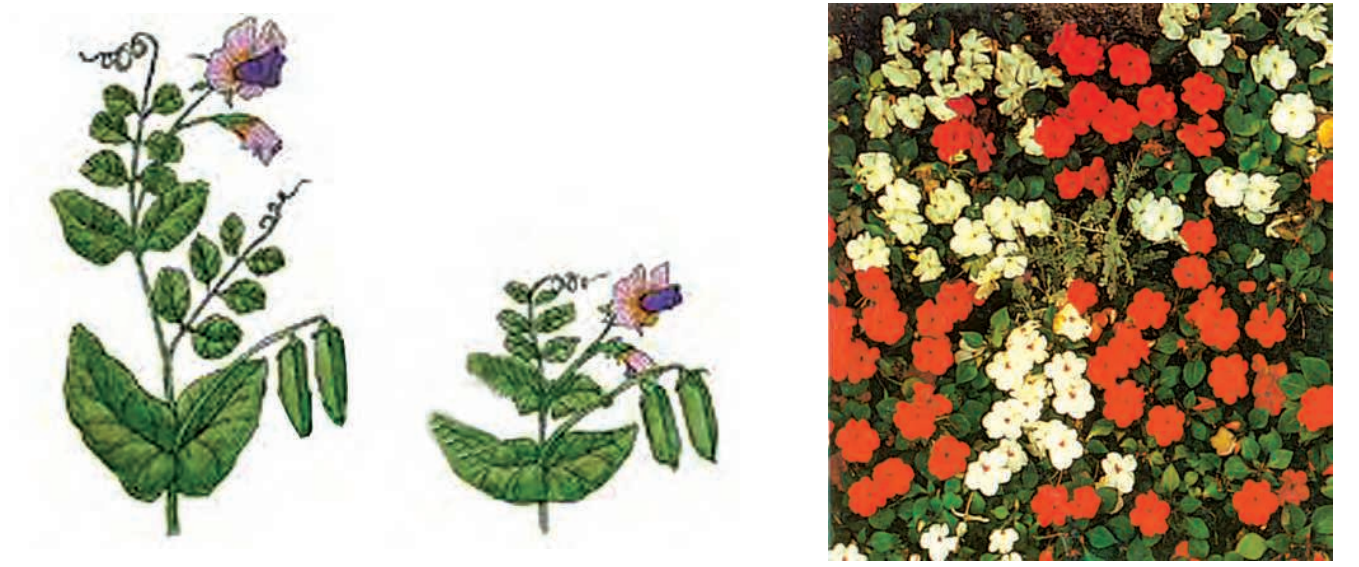
The characteristic (or trait) which is visible in an organism is called its phenotype. For example, being ‘tall’ or ‘dwarf’ (short) are phenotypes of a plant because these traits can be seen by us or they are visible to us. The phenotype of an organism is actually its physical characteristic which is determined by its genotype. For example, genotype TT or Tt results in a tall phenotype and the genotype tt results in a dwarf phenotype.
When two parents cross (or breed) to produce progeny (or offsprings), then their progeny is called first filial generation or F₁ generation (where F stands for Filial which denotes progeny of a cross).
When the first generation progeny cross (or breed) among themselves to produce second generation progeny, then this progeny is called second filial generation or F₂2 generation. In other words, the generation produced by crossing two F₁ progeny is called F₂ generation. An example will make it more clear. Mother and father are parental generation. Their children are F₁ generation, and the grandchildren are F₂ generation.

Gregor Mendel was the first scientist to make a systematic study of patterns of inheritance which involved the transfer of characteristics from parents to progeny. He did this by using different varieties of pea plants (Pisum sativum) which he grew in his garden. Some of the characteristics (or traits) of the pea plants whose transmission to progeny was investigated by Mendel were height of pea plant or length of stem of pea plant (tall or dwarf), shape of seeds (round or wrinkled) and colour of seeds (yellow or green) .
A yet another contrasting characteristics (or traits) investigated were colours of flowers (white or violet). Mendel chose pea plants for studying inheritance because pea plants had a number of clear cut differences which were easy to tell apart. For example, some pea plants were ‘tall’ (having long stem) whereas others were ‘dwarf’ (having short stem). Some pea plants produced round-yellow seeds whereas others produced wrinkled-green seeds, etc.

Another reason for choosing pea plants was that they were self pollinating (which enabled them to produce next generation of plants easily). And finally, Mendel chose peaplants to study inheritance (and not animals including human beings) because many generations of pea plants can be produced in a comparatively short time span and their study is much simpler than that of animals. A new form of plant resulting from a cross (or breeding) of different varieties of a plant is known as a hybrid.
When we breed two pea plants having one contrasting characteristic each (or one trait each) to obtain new plants, then it is called a monohybrid cross. In monohybrid cross we will study the inheritance of one pair of contrasting characteristics ‘tallness’ and ‘dwarfness’ of the pea plants by their first generation and second generation progeny.
On the other hand, if we breed two pea plants having two contrasting characteristics each (or two traits each) to obtain new plants, then it is called a dihybrid cross. In the dihybrid cross we will study the inheritance of two pairs of contrasting characteristics of pea plants such as round-yellow seeds and wrinkled-green seeds.
“KSEEB SSLC Heredity and Evolution chapter summary”
Rules For The Inheritance of Traits: Mendel’s Contribution
Inheritance is the transmission of genetically controlled characteristics (or traits) from one generation to the next. We will now describe how Mendel studied the inheritance of characters or traits in various generations of pea plants cultivated by him. First we will discuss ‘monohybrid inheritance’ which concerns the inheritance of a single characteristic (or single trait) such as plant height. After that we will describe the dihybrid inheritance which involves the inheritance of two characteristics (or two traits) such as seed shape and seed colour.
KSEEB Class 10 SSLC Biology Chapter 4 Heredity and Evolution Monohybrid Inheritance and the Law of Segregation
- In order to trace the inheritance of a single pair of contrasting characteristics among the pea plants (like tall stem and short stem), Mendel crossed (cross-bred) the pure-bred pea plants differing in these traits and noted their occurrence in the progeny of succeeding generations.
- Mendel first crossed pure-bred tall pea plants with pure-bred dwarf pea plants and found that only tall pea plants were produced in the first generation or F₁ generation. No dwarf pea plants (or short pea plants) were obtained in the first generation of progeny. From this Mendel concluded that the first generation (or F₁ cross) showed the traits of only one of the parent plants : tallness. The trait of other parent plant, dwarfness, did not show up in the progeny of first generation.

- Mendel then crossed the tall pea plants of the first generation (F₁ generation) and found that tall plants and dwarf plants were obtained in the second generation (or F₂ generation) in the ratio of 3 : 1. In other words in the F₂ generation, three-fourth plants were tall and one-fourth were dwarf .Mendel noted that the dwarf trait of the parent pea plant which had seemingly disappeared in the first generation progeny, reappeared in the second generation.

Mendel said that the trait of dwarfness of one of the parent pea plant had not been lost, it was merely concealed or supressed in the first generation to re- emerge in the second generation. Mendel called the repressed trait of ‘dwarfness’ as ‘recessive trait’ and the expressed trait of ‘tallness’ as the ‘dominant trait’. In this way, Mendel’s experiments with tall and dwarf pea plants showed that the traits may be dominant or recessive.
Mendel also noted that all the pea plants produced from the hybrid tall parents of F₁ generation, were either tall or dwarf. There were no plants with intermediate height (or medium height) in-between the tall and dwarf plants. In this way, Mendel’s experiment showed that the traits (like tallness and dwarfness) are inherited independently.
This is because if the traits of tallness or dwarfness had blended (or mixed up), then medium sized pea plants would have been produced. Out of a total 1064 pea plants of F₂ generation, Mendel found that there were 787 tall pea plants and 277 dwarf pea plants. The ratio of tall plants to dwarf plants comes to be 787 : 277 2.84 1, which is approximately equal to 3 : 1.
Thus, a yet another result obtained from Mendel’s monohybrid inheritance experiment is that the ratio of tall plants to dwarf plants in the F₂ generation is 3 : 1. Since tallness is a dominant trait and dwarfness is a recessive trait, so we can also say that the contrasting progeny in the F₂ generation occur in the ratio of 3 dominant to 1 recessive. The ratio 3 : 1 is known as the monohybrid ratio.
The results of monohybrid cross enabled Mendel to formulate his first law of inheritance which is called the law of segregation. According to Mendel’s first law of inheritance : The characteristics (or traits) of an organism are determined by internal ‘factors’ which occur in pairs. Only one of a pair of such factors can be present in a single gamete. We will now explain the results of monohybrid cross of tall and dwarf pea plants theoretically by using Mendel’s first law of inheritance.
Explanation of Results of Monohybrid Inheritance
- Mendel said that each trait is determined by a pair of ‘factors´. This means that the pure-bred tall pea plant has two factors TT for the trait of tallness, and the pure-bred dwarf pea plant also has two factors tt for the trait of dwarfness.
- The factors of inheritance of tallness TT separate into two gametes T and T, and the factors for inheritance of dwarfness tt separate into two other gametes t and t (The traits are transmitted to progeny through these gametes).
- The gametes of tall pea plant then cross with the gametes of the dwarf pea plant by the process of fertilisation to form zygotes which then produce various progeny in the F₁ generation (or first generation) which consists of all tall plants. Thus, the F₁ generation possesses one factor of inheritance from each parent plant which were carried in gametes. The parental cross is shown clearly in the following chart :
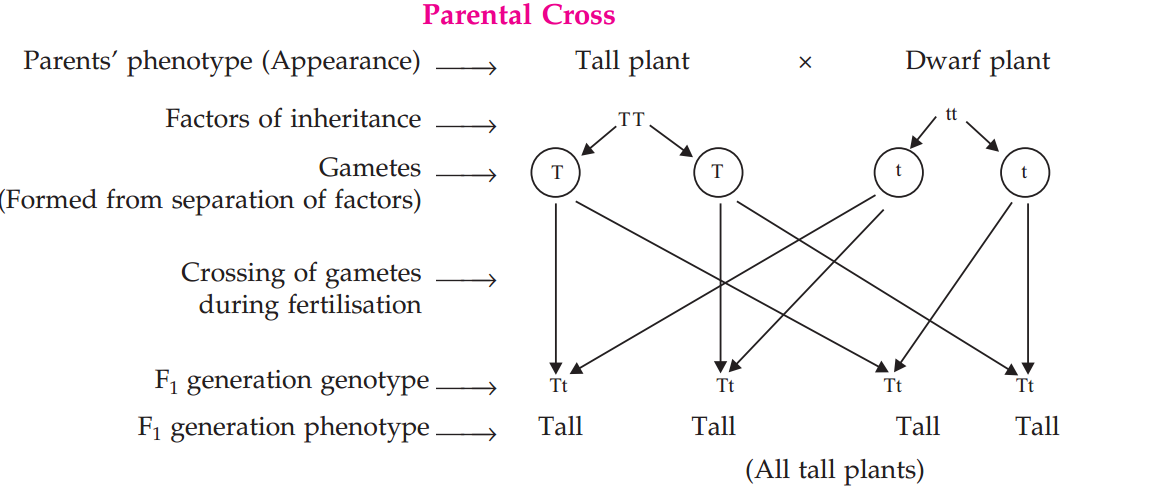
In the F₁ generation shown above, all the progeny plants have factors Tt in which T is the factor for tallness which is a dominant trait. Since all the plants in the F₁ generation have the factors Tt, so all of them are tall. The small letter t represents recessive trait of dwarfness, which does not show up in first generation in the presence of dominant trait T.
- (When two hybrid, tall pea plants (Tt) produced in the first generation (F₁) are now cross-bred with each other, then they will produce second generation (F₂) pea plants. This again happens by the separation of factors of inheritance of these tall plants into individual gametes and then crossing of the gametes during fertilisation as shown below :
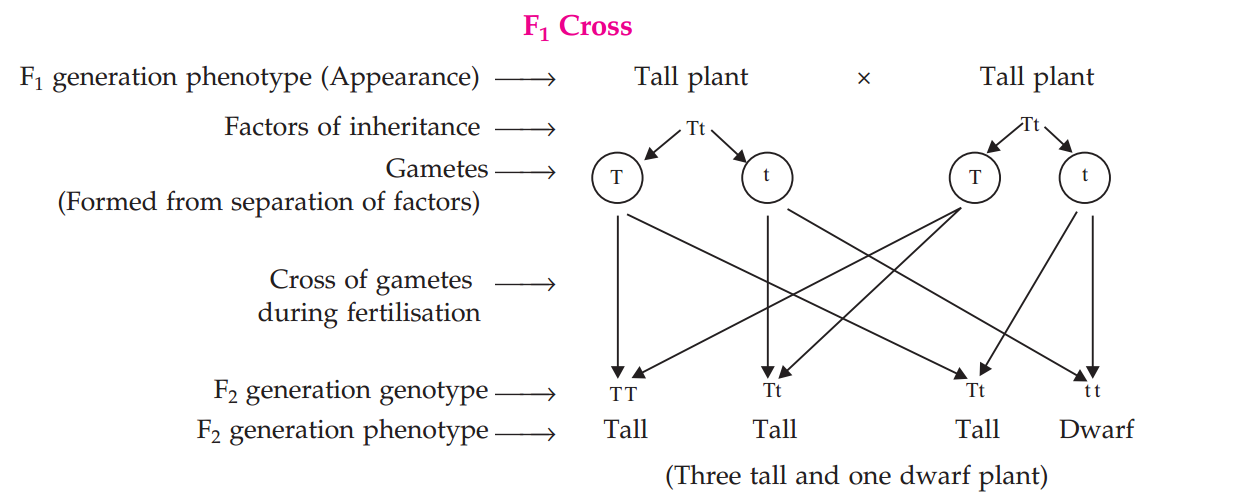
We can see from the above chart that in the F₂ generation (or second generation), the pea plants produced have genotype or inheritance factors TT, Tt, Tt and tt. Now, the plants having genotype TT, Tt and Tt all contain the factor T for dominant trait ´tallness’, so all the three plants (TT, Tt and Tt) are tall. The plant having the genotype tt has both factors t for the recessive trait ‘dwarfness’, so it is a dwarf plant.
Please note that though a single copy of factor T is enough to make a plant tall but both copies of factor t (that is tt) are necessary to make a plant dwarf (or short). In the F₂ generation, we get 1 plant having genotype TT, 2 plants having genotype Tt and 1 plant having genotype tt. So, the genotypic ratio in monohydrid cross will be :
TT : Tt : tt = 1 : 2:1
Again, in the F₂ generation, we get 3 tall plants and 1 dwarf plant, so the phenotypic ratio in monohybrid cross will be : This result is the same as that obtained by Mendel through experiments.
Tall plants: Dwarf plants= 3:1
Dihybrid Inheritance and the Law of Independent Assortment
Dihybrid inheritance involves the inheritance of two pairs of contrasting characteristics (or contrasting
traits) at the same time. The two pairs of contrasting characteristics chosen by Mendel were shape and colour of seeds : round-yellow seeds, and wrinkled-green seeds .
In order to trace the inheritance of two pairs of contrasting traits, Mendel crossed pea plants having round-yellow seeds with pea plants having wrinkled-green seeds and noted their occurrence in the succeeding generations of pea plants. Mendel made the following
observations:
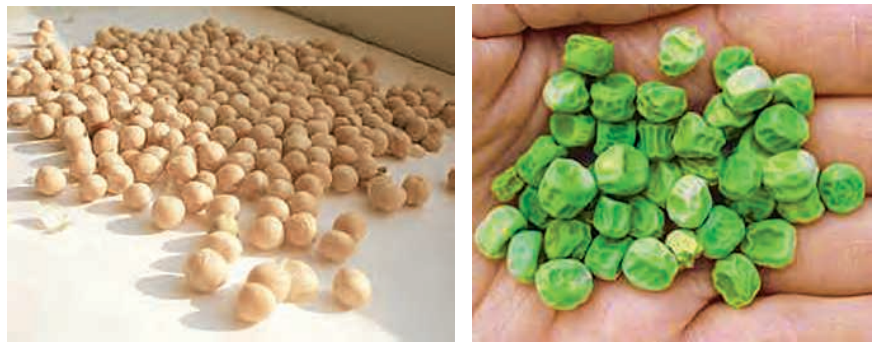 Mendel first crossed pure-bred pea plants having round-yellow seeds with pure-bred pea plants having wrinkled-green seeds and found that only round-yellow seeds were produced in the first generation. No wrinkled-green seeds were obtained in the F₁ generation. From this it was concluded that round shape and yellow colour of the seeds were dominant traits over the wrinkled shape and green colour of the seeds.
Mendel first crossed pure-bred pea plants having round-yellow seeds with pure-bred pea plants having wrinkled-green seeds and found that only round-yellow seeds were produced in the first generation. No wrinkled-green seeds were obtained in the F₁ generation. From this it was concluded that round shape and yellow colour of the seeds were dominant traits over the wrinkled shape and green colour of the seeds.- When the F₁ generation pea plants having round-yellow seeds were cross-bred by self pollination, then four types of seeds having different combinations of shape and colour were obtained in second generation or F₂ generation. These were round-yellow, round-green, wrinkled-yellow and wrinkled-green seeds. Mendel collected a total of 556 F₂ seeds and counted them shape wise and colour wise. He got the the following result :
Round-yellow seeds 315
Round-green seeds 108
Wrinkled-yellow seeds 101
Wrinkled-green seeds 32
The phenotypic ratio of different type of seeds can be written as :
Round Round Wrinkled Wrinkled
yellow : green : yellow : green = 315 : 108 : 101 : 32
seeds seeds seeds seeds = 9 : 3 : 3 : 1
Thus, the ratio of each phenotype (or appearance) of the seeds in the F2 generation is 9:3 :3 : 1. This is known as the dihybrid ratio. Mendel observed that he had started with two combinations of characteristics in seeds : round-yellow and wrinkled-green, and two new combinations of characteristics had appeared in the F₂ generation : round- green and wrinkled-yellow.
On the basis of this observation, Mendel concluded that though the two pairs of original characteristics (seed shape and colour) combine in the F₁ generation but they separate and behave independently in subsequent generations. The results of dihybrid cross enabled Mendel to formulate his second law of inheritance which is called the law of independent assortment.
According to Mendel’s second law of inheritance : In the inheritanceof more than one pair of traits in a cross simultaneously, the factors responsible for each pair of traits are distributed independently to the gametes.

Explanation of Results of Dihybrid Inheritance
In the dihybrid cross, the parent plants having the phenotype round-yellow seeds have the factors of inheritance or gene combination RRYY (in which RR are the dominant genes for round shape whereas YY are the dominant genes for yellow colour). On the other hand, the parent plants having the phenotype wrinkled-green seeds have the factors of inheritance or gene combination rryy (in which rr are the recessive genes for wrinkled shape and yy are the recessive genes for green colour). Keeping these points in mind, we can now show the dihybrid cross by drawing a chart as we did in the case of a monohybrid cross. The chart showing the dihybrid cross between pea plants having round-yellow seeds and wrinkled-green seeds is given below.

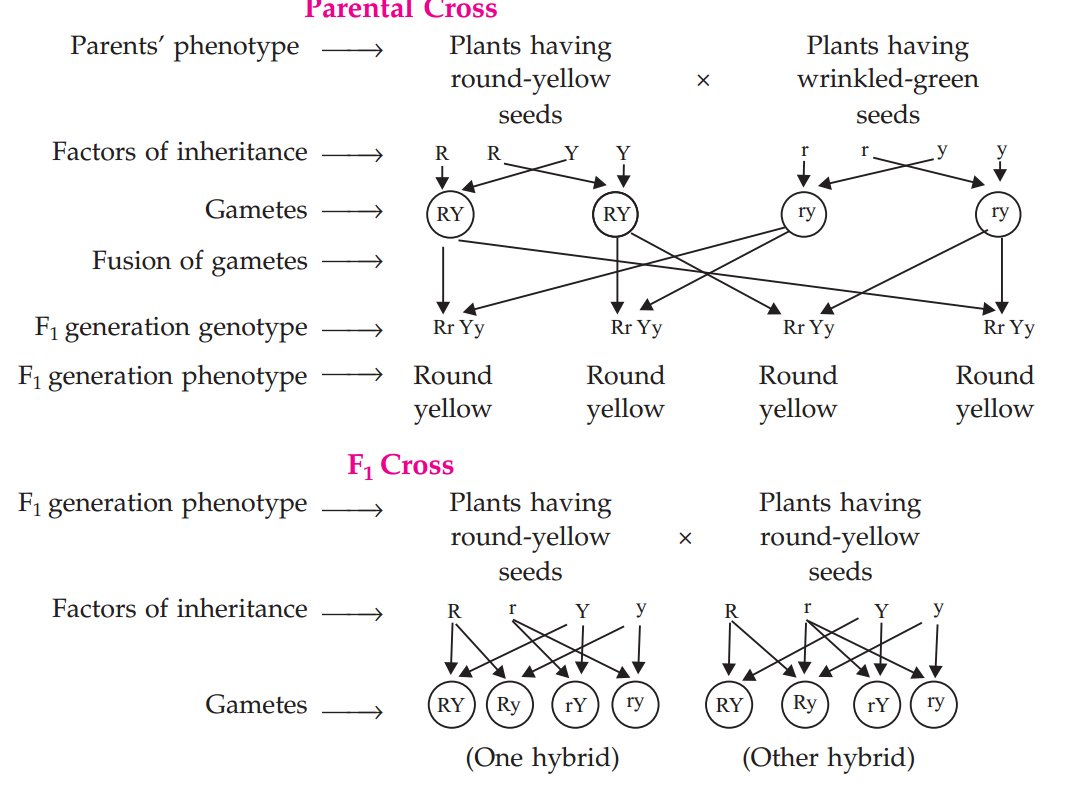
How Are Characteristics (or Traits) Transmitted to Progeny
Genes are responsible for the characteristic features (or traits) of an organism : plant or animal. The characteristics or traits of parents are transmitted to their progeny (offsprings) through genes present on their chromosomes during the process of sexual reproduction. This happens as follows. Genes work in pairs. There is a pair of genes for each characteristic of an organism (one is dominant gene and the other is recessive gene).
Each parent possesses a pair of genes for each characteristic on a pair of chromosomes. However, each parent passes only one of the two genes of the pair for each characteristic to its progeny through gametes. Thus, the male gamete and female gamete carry one gene for each characteristic from the gene pairs of parents (which are located on the pair of chromosomes).
But when a male gamete fuses with a female gamete during fertilisation, they make a new cell called zygote with a full set of genes (on a full set of chromosomes). This zygote grows and develops to form a new organism having characteristics (or traits) from both the parents which it has inherited through genes.
“Class 10 Karnataka Board Biology Chapter 4 notes”
The two genes (or pair of genes) responsible for a particular characteristic are always present on the corresponding positions of the pair of chromosomes. For example, in Figure 15 the two genes for the same characteristic (length of plant stem), are present on the corresponding positions of the pair of chromosomes. One gene of the pair is for ‘tallness’ and the other is for ‘dwarfness’.
Please note that though the progeny inherits two genes (or a pair of genes) for each trait from its parents but the trait shown by the progeny depends on which inherited gene is dominant of the two. For example, if a pea plant progeny (or hybrid) inherits the gene for tallness (T) from one parent and the gene for dwarfness (t) from the other parent, then it will show the trait of ‘tallness’ and become a tall plant because the gene for tallness is dominant over the gene for dwarfness.
So, although the gene for dwarfness (t) is present in all the cells of the hybrid plants, it does not show its effect (because it is a recessive gene).
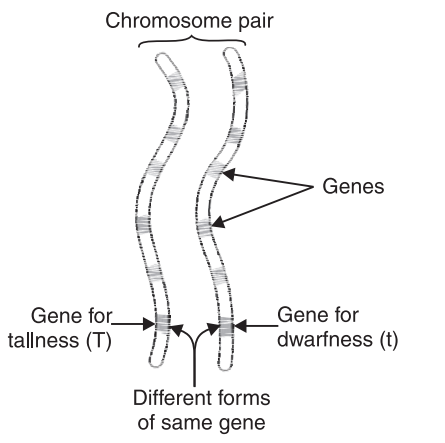
If, however,both the parent plants pass on one copy each of the recessive gene for dwarfness (t) making the genotype (tt), then the traits of dwarfness will appear in the progeny plant. Please note that the genes for ‘tallness’ and ‘dwarfness’ are not to be considered two different genes. They are just the two forms of the same gene which controls only one characteristic feature of a plant : length of its stem. But there can be increase in length of stem making the plant tall or decrease in the length of stem, making the plant dwarf.
How do Genes Control the Characteristics (or Traits)
A gene is the section of DNA on a chromosome which codes for the formation of a protein controlling a specific characteristic (or trait) of the organism. Suppose a plant progeny has gene for the characteristic called ‘tallness’. Now, the gene for tallness will give instructions to the plant cells to make a lot of plant growth hormones.
And due to the formation of excess of plant growth hormones, the plant will grow too much and hence become tall. On the other hand, if the plant has the gene set for dwarfness, then less plant growth hormones will be produced due to which the plant will grow less, remain short and hence become a dwarf plant.
Just like plants, the characteristics (or traits) in animals (including human beings) are also transmitted from the parents through genes by the process of sexual reproduction. We will now give an example of the transmission of colour of hair from the parents (father and mother) to the child. Before we do that please keep in mind that black hair is a phenotype produced by the genotype HH or Hh. On the other hand, blonde hair (pale yellow hair) is a phenotype produced by the genotype hh. Let us give the example now.
“Detailed notes on Heredity and Evolution for Class 10 SSLC”
A mother has black hair, the father has blonde hair (pale yellow hair), and the child has black hair . This can be explained on the basis of transmission of genes for ‘hair colour’ from the mother and father to the child as follows: Mother’s cell contain two genes HH for black hair. Both the genes HH are dominant genes, so the mother has black hair. Father’s cells contain two genes (hh) for blonde hair. The two genes hh are recessive genes, so the father has blonde hair (or pale yellow hair) .
Now, during the process of reproduction, the mother transmits one of the dominant genes H for black hair to the child and the father transmits one of his recessive genes h for blonde hair to the child. Due to this, the child has the genes Hh for her hair.

Now, the gene H for black hair is the dominant gene but the gene h for blonde hair is the recessive gene. The dominant gene H for black hair shows its effect due to which the child has black hair (see Figure 18). The recessive gene h for blonde hair cannot show its effect in the presence of dominant gene H for black hair. Please note that the genes which dominate other genes are called dominant genes, and the genes which get dominated are called recessive genes.
We will now describe the inheritance of blood groups by the children from their parents. Please note that the gene which controls the blood groups is represented by the letter I. This gene has three different forms (called alleles) which are represented as IA, IB and IO.
How Blood Groups are Inherited
A person has one of the four blood groups : A, B, AB or O. This blood group system is controlled by a gene which has three different forms denoted by the symbols Iª, I³ and Iº. The genes Iª and I³ show no dominance over each other, that is, they are codominant. However, genes IA and I³ both are dominant over the gene Iº.
In other words, the blood gene Iº is recessive in relation to genes IA and IB. Although there are three gene forms (called alleles) for blood, but any one person can have only two of them. So, the blood group of a person depends on which two forms of the genes he possesses.

- If the genotype (gene combination) is IA IA, then the blood group of the person is A. And if the genotype is IA IO even then the blood group is A (because IO is a recessive gene).
- If the genotype is IB IB, then the blood group of the person is B. And if the genotype is IB IO even then the blood group is B (because Iº is a recessive gene).
- If the genotype is IAI³, then the blood group of the person is AB.
- If the genotype is 1º10, then the blood group of the person is O.
KSEEB Class 10 SSLC Biology Chapter 4 Heredity and Evolution Sex Determination
A person can have a male sex or a female sex. The process by which the sex of a person is determined is called sex determination. Genetics is involved in the determination of the sex of a person. This can be explained as follows. The chromosomes which determine the sex of a person are called sex chromosomes. There are two types of sex chromosomes, one is called X chromosome and the other is called Y chromosome.
- A male (man or father) has one X chromosome and one Y chromosome [see Figure 20(a)]. This means that half the male gametes or half the sperms will have X chromosomes and the other half will have Y chromosomes.
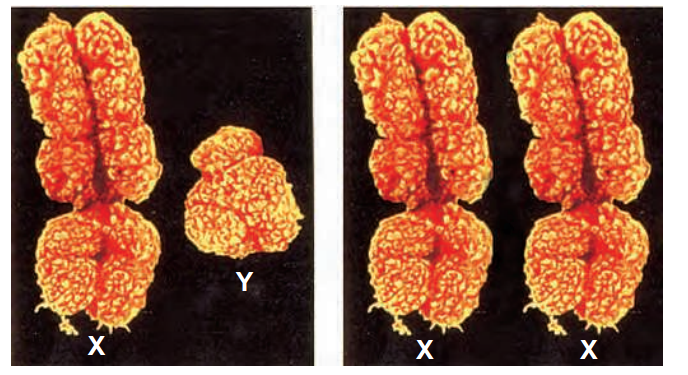
A female (woman or mother) has two X chromosomes (but no Y chromosomes). This means that all the female gametes called ova (or eggs) will have only X chromosomes.
The sex of a child depends on what happens at fertilisation :
- (a) If a sperm carrying X chromosome fertilises an ovum (or egg) which carries X chromosome, then the child born will be a girl (or female). This is because the child will have XX combination of sex chromosomes.
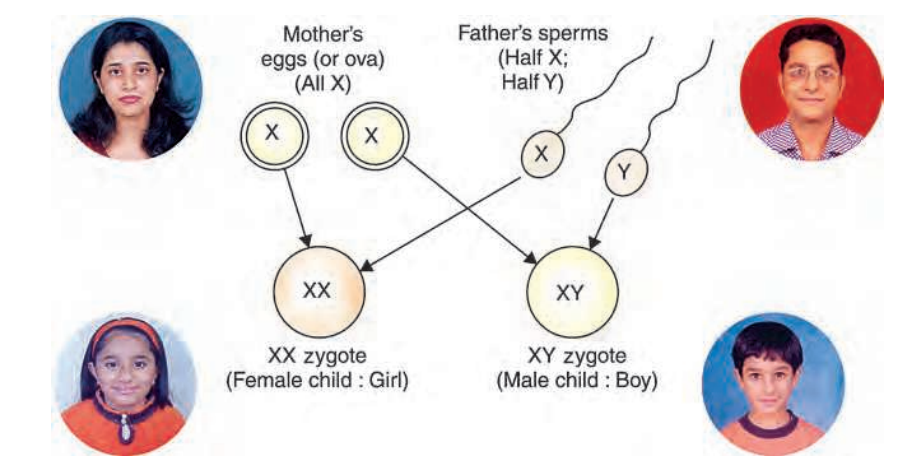
Please note that it is the sperm which determines the sex of the child. This is because half of the sperms have X chromosomes and the other half have Y chromosomes. Thus, there is a 50 per cent chance of a boy and a 50 per cent chance of a girl being born to the parents. This is why the human population is roughly half males and half females. From the above discussion we conclude that if the father (man or husband) contributes X sex chromosome at fertilisation through his sperm, the baby born will be a girl.
On the other hand, if the father (man or husband) contributes a Y sex chromosome at fertilisation through his sperm, then the baby born will be a boy. This means that it is the sex chromosome contributed by father (man or husband) which decides the sex of the baby which the mother (woman or wife) will give birth to. Thus, father (man or husband) is responsible for the sex of the baby (boy or girl) which is born. The belief that mother (woman or wife) is responsible for the sex of her baby is absolutely wrong.
In many ignorant Indian families, the mother (woman or wife) is held responsible for the birth of a girl child and unnecessarily harassed by her in-laws (sasural). Such people should understand that it is the husband who is responsible for the birth of a girl child (and not his wife). Moreover, a girl is no less than a boy.
In some of the animals, sex determination is also controlled by the environmental factors. For example, in some reptiles, the temperature at which the fertilised egg is incubated before hatching, plays a role in determining the sex of the offspring. It has been found that in a turtle (Chrysema picta), high incubation temperature leads to the development of female offsprings (or female progeny).
On the other hand, in the case of a lizard (Agama agama), high incubation temperature results in male offsprings (or male progeny). In some animals, such as snails, individuals can change sex, indicating that sex is not determined genetically in such animals. Before we go further and discuss acquired and inherited traits of organisms.
KSEEB Class 10 SSLC Biology Chapter 4 Heredity and Evolution Acquired and Inherited Traits
A trait (or characteristic) of an organism which is ‘not inherited’ but develops in response to the environment is called an acquired trait. For example, if a beetle does not get sufficient food for a considerable time, its weight will be reduced due to starvation. The ‘low weight’ of this beetle is an acquired trait of the beetle which has been acquired in response to the environment which contained insufficient food. Again, suppose the tail of a mouse gets cut.
The ‘cut tail’ of this mouse is also an acquired trait which has been been brought about by some agent in its environment. A man may know how to swim or roller skate or speak French or may have a scar on the face from a cut he got in an accident.
All these are acquired traits (or characteristics) which the man has picked up (or acquired) himself as he goes through life. The man is not born with these traits and he cannot pass on these traits to his children. The acquired traits of organisms cannot be passed on to their future generations. The reason for this is discussed below.

We have already studied that the traits (or characteristics) of parents are passed to their offsprings through genes in reproductive cells (or gametes) during the process of reproduction. So, for the trait of an organism to be passed on, it must have been caused by a change in the genes (or DNA) present in the reproductive cells of the organism.
In other words, only those traits can be transmitted to future generations in which changes have occurred in the genes (or DNA) present in the reproductive cells (or gametes) of parent organisms. The changes in the non-reproductive body cells of an organism cannot be inherited by its offsprings.
This will become clear from the following examples.
When the weight of a beetle is reduced too much due to starvation, then though there is a change in the normal body cells of the beetle but no change takes place in the genes (or DNA) present in its reproductive cells (or gametes). And since there is no change in the genes (or DNA) of gametes, this acquired trait (of low weight) of beetle cannot be inherited by its offsprings.
So, if some generations of beetles are low in body weight because of the availability of less food, then this is not an example of evolution because this change cannot be inherited over generations. Whenever these beetles will get sufficient food, they will become healthy again and the trait of ‘low body weight’ will disappear.
Let us discuss the other example now. If we breed some mice, all the progeny of mice will have tails, just like their parents. Now, we cut the tails of these first generation mice surgically and breed them, we will get new mice, all with full tails. It has been observed that even after cutting the tails of mice for a number of generations, a tail-less mouse is never born.

Actually, the cut tail of mice is an acquired trait which is never passed on to their progeny. This is because cutting the tails of mice does not change the genes of their reproductive cells (or gametes). And since the acquired trait of ‘cut tails’ does not bring about by a change in the genes (or DNA) of the reproductive cells. The green colour of this beetle is an inherited trait which can be passed on to the next generations.
The change from red beetle to green beetle can be considered to be an example of evolution because it helps in its survival by mixing with green bushes. Inherited traits actually mean the characteristics which we receive from our parents. This point will become more clear from the following example. Suppose a father has red curly hair, brown eyes, a snub nose and a cleft chin. Again suppose that the mother has straight black hair, blue eyes, a


long thin nose and a pointed chin . The children in the family inherit some characteristics from each of their parents. For example, two children have red hair like father but one of them has straight red hair while the other one has curly red hair. The two children have black hair like the mother. Again, two children have brown eyes like father but the other two have blue eyes like the mother. And finally, two children have snub nose and cleft chin like father whereas the other two have a long thin nose and a pointed chin.
KSEEB Class 10 SSLC Biology Chapter 4 Heredity and Evolution
There is an enormous ‘number’ and ‘types’ of living organisms (plants and animals) on this earth. In addition to this wide variety of living organisms, the remains of the dead organisms which lived in the remote past (called fossils) are also known. An important question now arises : How and from where has such a great variety of living organisms come to exist on this earth? Also, how the human beings have evolved on this earth? All these things are studied in the branch of biology called ‘evolution’.
The word ‘evolution’ has been derived from the Latin word ‘evolvere’ which means to ‘unroll’ or ‘unfold’. Evolution is a kind of gradual unfolding (or formation) of the new organisms from the pre-existing primitive organisms through slow and steady changes. We can now define evolution as follows: Evolution is the sequence of gradual changes which take place in the primitive organisms over millions of years in which new species are produced.
Since the evolution is of the living organisms, so it is also called ‘organic evolution’. It is through the constant process of evolution taking place in the organisms since the origin of life that such an enormous variety of plants and animals have come to exist on this earth at present. All the plants and animals (or organisms) which we see today around us have evolved from some or the other ancestors that lived on this earth long, long ago.
The process of evolution will become clear from the following example of ‘pterosaur’. Pterosaur is an anicient flying reptile which lived on the earth about 150 million years ago. The development of pterosaur is an example of evolution. It began life as a big lizard which could just crawl on land [see Figure 26(a)]. Over millions of years, small folds of skin developed between its feet which enabled it to glide from tree to tree . Over many, many generations, spread over millions of years, the folds of skin, and

the bones and muscles supporting them grew to form wings which could make it fly. In this way, an animal which crawled on ground evolved into a flying animal. This evolution led to the formation of a new species (of a flying reptile).
Evidences For Evolution
Various biological studies tell us that since their origin, living organisms have been undergoing changes in their organisation to evolve into new forms. A number of common features of different kinds of organisms provide evidence in favour of evolution because they can be considered to have evolved from the common ancestor. The more characteristics (or features) two species have in common, the more closely they will be related. And the more closely they are related, the more recently they will have had a common ancestor.
We will now give some of the evidences which indicate the occurrence of evolution. These evidences reinforce the view that the living organisms have evolved from common ancestors. Some of the important sources which provide evidences for evolution are:
- Homologous organs,
- Analogous organs, and
- Fossils.
We will now discuss all these evidences for evolution briefly.
Homologous Organs Provide Evidence for Evolution
If we look at the way in which living organisms are made, we can often see quite striking similarities in btheir construction. One of these is the presence of homologous organs. Those organs which have the same basic structure (or same basic design) but different functions are called homologous organs. The homologous organs of different animals provide evidence for evolution. This will become clear from the following examples.
There are many organs in different groups of animals (or plants) which all seem to be built from the same basic design but are used for many different purposes. These are called homologous organs. For example, the forelimbs of a man, a lizard (reptile), a frog (amphibian), a bird and a bat (mammal) seem to be built from the same basic design of bones (as shown in Figure 27), but they perform different functions. The
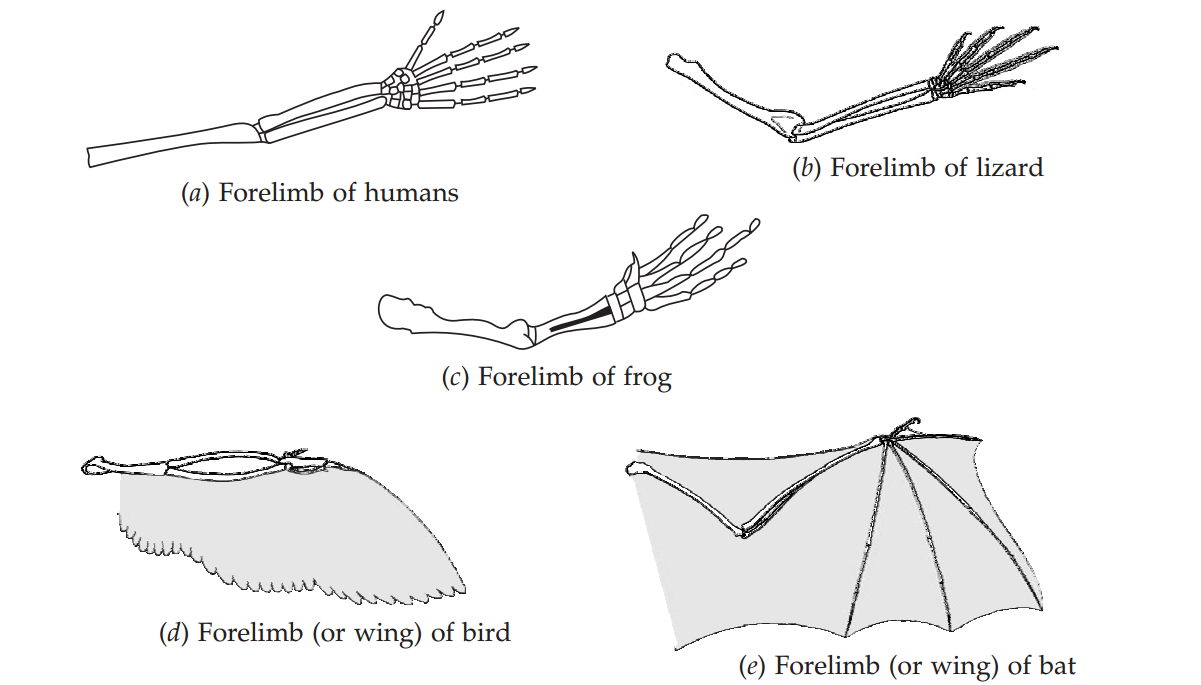
forelimbs of a human (man) are used for grasping; the forelimbs of a lizard are used for running; the forelimbs of a frog are used to prop up the front end of its body when at rest, and also act as shock absorbers when the frog lands back on the ground after a leap; whereas the forelimbs of a bird and a bat are modified for flying. Since the forelimbs of a human, a lizard, a frog, a bird and a bat have similar structures (or design) but perform different functions, they are the homologous organs.
The presence of homologous forelimbs in humans (man), a lizard, a frog, a bird and a bat indicate that all these forelimbs have evolved from a common ancestral animal which had a ‘basic design’ limb. In other words, it tells us that a human, a lizard, a frog, a bird and a man, all have evolved from a common ancestor.
“KSEEB SSLC Chapter 4 Heredity and Evolution important topics”
Thus, the presence of homologous organs in different animals provides evidence for evolution by telling us that they are derived from the same ancestor who had the ‘basic design’ of the organ on which all the homologous organs are based. Please note that the wings of a butterfly (which is an insect) and the wings of a bat cannot be considered to be homologous organs because they have different basic designs (though they are used for the same purpose of flying).
Analogous Organs Provide Evidence for Evolution
Those organs which have different basic structure (or different basic design) but have similar appearance and perform similar functions are called analogous organs. The analogous organs provide the evidence for evolution. This point will become clear from the following discussion. There are many organs in different groups of animals which seem to be built from different basic structure but appear to be similar in shape and perform similar functions.
These are called analogous organs. For example, the wings of an insect and a bird have different structures (the insects have a fold of membranes as wings which are associated with a few muscles whereas a skeleton, flesh and feathers support bird’s wings) but they perform the same function of flying . Since the wings of insects and birds have different structures (or different designs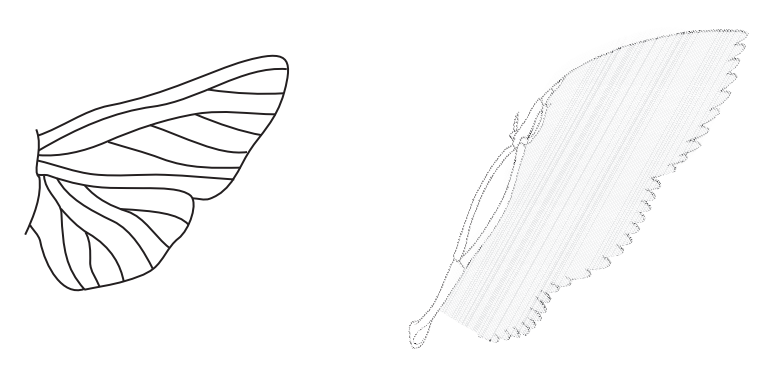
but perform similar functions, they are analogous organs. Now, since the analogous organs have different basic design, so they do not indicate a common ancestor for the organism. The analogous organs provide evidence for the evolution in another way. The presence of analogous organs indicates that even the organisms having organs with different structures can adapt to perform similar functions for their survival under hostile environmental conditions.
Thus, the presence of analogous organs in different animals provide evidence for evolution by telling us that though they are not derived from common ancestors, they can still evolve to perform similar functions to survive, flourish and keep on evolving in the prevailing environment. The analogous organs actually provide a mechanism for evolution.
Fossils Provide Evidence for Evolution
The remains (or impressions) of dead animals or plants that lived in the remote past are known as
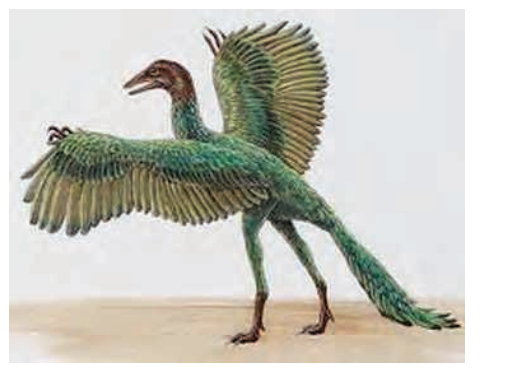
fossils. The fossils provide evidence for evolution. For example, a fossil bird called Archaeopteryx looks like a bird but it has many other features which are found in reptiles. This is because Archaeopteryx has feathered wings like those of birds but teeth and tail like those of reptiles. Archaeopteryx is, therefore, a connecting link between the reptiles and
birds, and hence suggests that the birds have evolved from the reptiles.
Thus, fossils provide the evidence that the present animals (and plants) have originated from the previously existing ones through the process of continuous evolution. We will now describe how fossils are formed. Usually, when organisms (plants or animals) die, their bodies will decompose by the action of micro-organisms in the presence of oxygen, moisture, etc.
Sometimes, however, the conditions in the environment are such (like absence of oxygen or moisture, etc), which do not let the body of the organism to decompose completely. It is such body (or body part) of an

organism which we get as fossil on digging the earth . In many cases the soft parts of the organisms get decomposed and what we get as a fossil is a skeleton of hard parts (like bones, etc). Even the soft parts of the plants and animals (which usually decompose quickly) are sometimes preserved as fossils in the form of their impressions inside the rocks. For example, if a dead leaf gets caught in mud, it will not decompose quickly.
The mud around the leaf will set around it as a mould, gradually harden to form a rock and retain the impression of the whole leaf. This forms a leaf fossil which can be dug out from the earth a long time later . The fossil of a dead insect caught in mud is also formed in a similar way to leaf fossil. All such preserved impressions of the body parts of the once living organisms are also called fossils.

Fossils are obtained by digging into the earth. The age of fossils can be estimated in two ways: by the relative method, and by the carbon dating method. The relative method works like this: When we dig into the earth, we find fossils at different depths. The fossils which we find in layers closer to the surface of the earth are more recent; the fossils which are found in deeper layers are older; whereas the fossils found in the deepest layers of earth are the oldest ones.
Fossils which we find today were once living objects. All the living objects contain some carbon- 14 atoms which are radioactive. When a living object dies and forms fossil, its carbon-14 radioactivity goes on decreasing gradually. In the carbon dating method, the age of fossils is found by comparing the carbon-14 radioactivity left in fossils with the carbon-14 radioactivity present in living objects today.
There are various kinds of fossils. Some of the important fossils which have been studied are those of ammonite, trilobite and dinosaur. Ammonites were the invertebrate animals (molluscs) with a flat, coiled, spiral shell which lived in the sea. The estimation of the age of ammonite fossils have told us that they are about 180 million years old. This means that ammonites lived in the sea about 180 million years ago.
Another invertebrate animal fossil which has been studied is that of trilobite Trilobites were marine arthropods which were common between 400 to 600 million years ago. Dinosaurs are extinct carnivorous or herbivorous reptiles (The word ‘dinosaur’ means ‘terrible lizard’). The estimation of the age of dinosaur fossils have told us that they first appeared on earth about 250 million years ago and became extinct about 65 million years ago. It is clear from the above discussion that we can

even study about those species which are extinct (no longer exist), by studying their fossils which are found during the digging of earth.
KSEEB Class 10 SSLC Biology Chapter 4 Heredity and Evolution Darwin’s Theory of Evolution
Charles Robert Darwin gave the theory of evolution in his famous book ‘The Origin of Species’. The theory of evolution proposed by Darwin is known as ‘The Theory of Natural Selection’. This theory is called the theory of natural selection because it suggests that the best adapted organisms are selected by nature to pass on their characteristics (or traits) to the next generation. Darwin’s theory of evolution applies to plants as well as animals.
Darwin’s theory of evolution can be described as follows:

- Within any population, there is natural variation. Some individuals have more favourable variations than others.
- Even though all species produce a large number of offsprings, populations remain fairly constant naturally.
- This is due to the struggle between members of the same species and different species for food, space and mate.
- The struggle for survival within populations eliminates the unfit individuals. The fit individuals possessing favourable variations survive and reproduce. This is called natural selection (or survival of the fittest).
- The individuals having favourable variations pass on these variations to their progeny from generation to generation.
- These variations when accumulated over a long period of time, lead to the origin of a new species.
We will now understand Darwin’s theory of evolution by ‘natural selection’ by taking an example. No two animals are ever exactly alike. So some changes always appear when animals produce their progeny by sexual reproduction. For example, one of the progeny may be tall (having long legs) than the other progeny. Thus, there may be a variation of height in the progeny .
Now, the advantage of long legs to the progeny is that when no food (grass, etc.) is available on the ground, then this progeny having long legs can reach the leaves on tall trees, eat them as food and survive . On the other hand, the progeny which have short height (due to short legs) cannot reach the leaves on tall trees, they will not get any food, they will starve and hence die . Thus, nature has selected the animal with long legs to survive (because it is the fittest animal under these circumstances).
Now, since long legs help in survival, the long- legged animals will live long enough to produce their offsprings. The offspring will inherit long legs. So, all the future generations will have long-legged animals . In this way, the animals having short legs have evolved into animals having long legs due to variation. This is an example of evolution.

we can now define natural selection as follows: Natural selection is the process of evolution of a species whereby characteristics which help individual organisms to survive and reproduce are passed on to their offspring, and those characteristics which do not help are not passed on. Though Darwin’s theory was widely accepted, but it was criticised on the ground that it could not explain ‘how the variations (which lead to origin of new species) arise’. With the progress in genetics, the source of variations was explained to be the ‘genes’. Genes vary in natural population.
Genetic variation is the raw material of evolution. So, the Darwin’s theory was modified accordingly. These days, the most accepted theory of evolution is the Synthetic Theory of Evolution in which the origin of species is based on the interaction of ‘genetic variation’ and ‘natural selection’. Sometimes, a species (a type of animal or plant) may completely die out. It may become extinct. Dodo was a large flightless bird which has become extinct . Once a species is extinct, its genes are lost for ever. It cannot re-emerge at all. The small numbers of surviving tigers are a cause of worry from the

point of view of genetics because if they all die out and become extinct, their genes will be lost for ever . Our coming generations will not be able to see tigers at all. We should, therefore, make all out efforts to protect tigers (and other endangered species) to prevent them from extinction.
KSEEB Class 10 SSLC Biology Chapter 4 Heredity and Evolution Specitation
A species is a population of organisms consisting of similar individuals which can breed together and produce fertile offspring. Species can be of plants or of animals. Wheat, paddy, sunflower, lotus, mango, neem, humans, tiger, dog and cat, etc., are all examples of various types of species. The human beings who look so different from each other in terms of size, colour and looks are said to belong to the same species (Homo sapiens) because they can interbreed to produce fertile offsprings (sons and daughters).
The process by which new species develop from the existing species is known as speciation. In simple words, the formation of new species is called speciation. We will now explain how new species are formed from the existing species of various populations.
“Heredity and Evolution Class 10 SSLC exam preparation”
In most of the cases, new species are formed when the population of same species splits into two separate groups which then get isolated from each other geographically by the barriers such as mountain ranges, rivers or the sea. The geographical isolation of the two groups of population leads to their reproductive isolation due to which no genes are exchanged between them. However, breeding continues within the isolated populations producing more and more generations.
Over the generations, the processes of genetic drift (random change in gene frequency), and natural selection operate in different ways in the two isolated groups of population and make them more and more different from each other. After thousands of years, the individuals of these isolated groups of population become so different that they will be incapable of reproducing with each other even if they happen to meet again.
We say that two new species have been formed. From the above discussion we conclude that the important factors which could lead to the rise (or formation) of a new species are the following :
- Geographical isolation of a population caused by various types of barriers (such as mountain ranges, rivers and sea). The geographical isolation leads to reproductive isolation due to which there is no flow of genes between separated groups of population.
- Genetic drift caused by drastic changes in the frequencies of particular genes by chance alone.
- Variations caused in individuals due to natural selection.
It should be noted that geographical isolation is the major factor in the speciation of sexually reproducing animals because it interrupts the flow of genes between their isolated populations through the gametes.
The geographical isolation, however, cannot be a major factor in the speciation of a self- pollinating plant species because it does not have to look to other plants for its process of reproduction to be carried out. Geographical isolation also cannot be a major factor in the speciation of an asexually reproducing organism because it does not require any other organism to carry out reproduction.
KSEEB Class 10 SSLC Biology Chapter 4 Heredity and Evolution of Eyes
The eye is a very important organ for animals. The eye is a complicated organ which cannot be generated
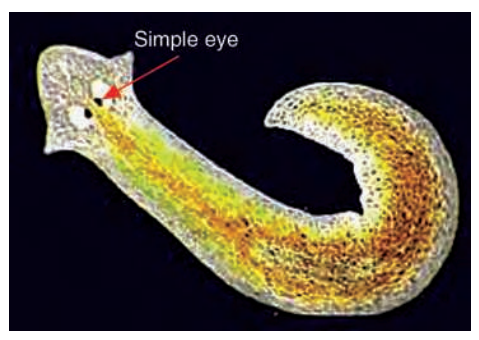
by a single DNA change. The complex body organs of animals such as eyes have been created in ‘stages’ over many generations. First of all the rudimentary eye (basic eye) like that of a flatworm (Planaria) was formed . The eyes of flatworm are very simple that are actually just ‘eye-spots’ which can detect light. Even these rudimentary eyes provide a survival advantage to flatworm.
Starting from this basic design, more and more complex eyes were then evolved in various organisms. Most of the animals have eyes. For example, the insects, octopus and invertebrates, all have eyes. The structure of eyes in each of these organisms is, however, different which suggests their separate evolutionary origins. The evolution of eye is an example of evolution by stages.
KSEEB Class 10 SSLC Biology Chapter 4 Heredity and Evolution of Feathers
Sometimes an evolutionary change produced in an organism for one purpose later on becomes more useful for an entirely different function. For example, birds evolved feathers as a means of providing insulation to their bodies in cold weather but later on these feathers became more useful for the purpose of flying.
Even some dinosaurs had feathers though they could not fly by using these feathers. Birds, however, adapted feathers for flying. The presence of feathers on birds tells us that the birds are very closely related to reptiles because dinosaurs (which had feathers) were reptiles.

KSEEB Class 10 SSLC Biology Chapter 4 Heredity and Evolution By Artificial Selection
In the evidence for evolution we have studied that very dissimilar looking structures can evolve from a common ancestral body design. But that was all guesswork about what happened in history long time ago. We will now give an example from the present time which will show that different looking organisms can in fact be created from the same basic design of the ancestor. The wild cabbage plant is a good example to prove that entirely different looking organisms can evolve from the same organism by the process of evolution.
“KSEEB Biology Chapter 4 Heredity and Evolution study material”
The only difference is that here we are using artificial selection for evolution in place of natural selection. This will become clear from the following discussion. The farmers have been cultivating wild cabbage as a food plant for over two thousand years and have produced (or evolved) entirely different looking vegetables like cabbage, broccoli, cauliflower, kohlrabi and kale from it by artificial selection .
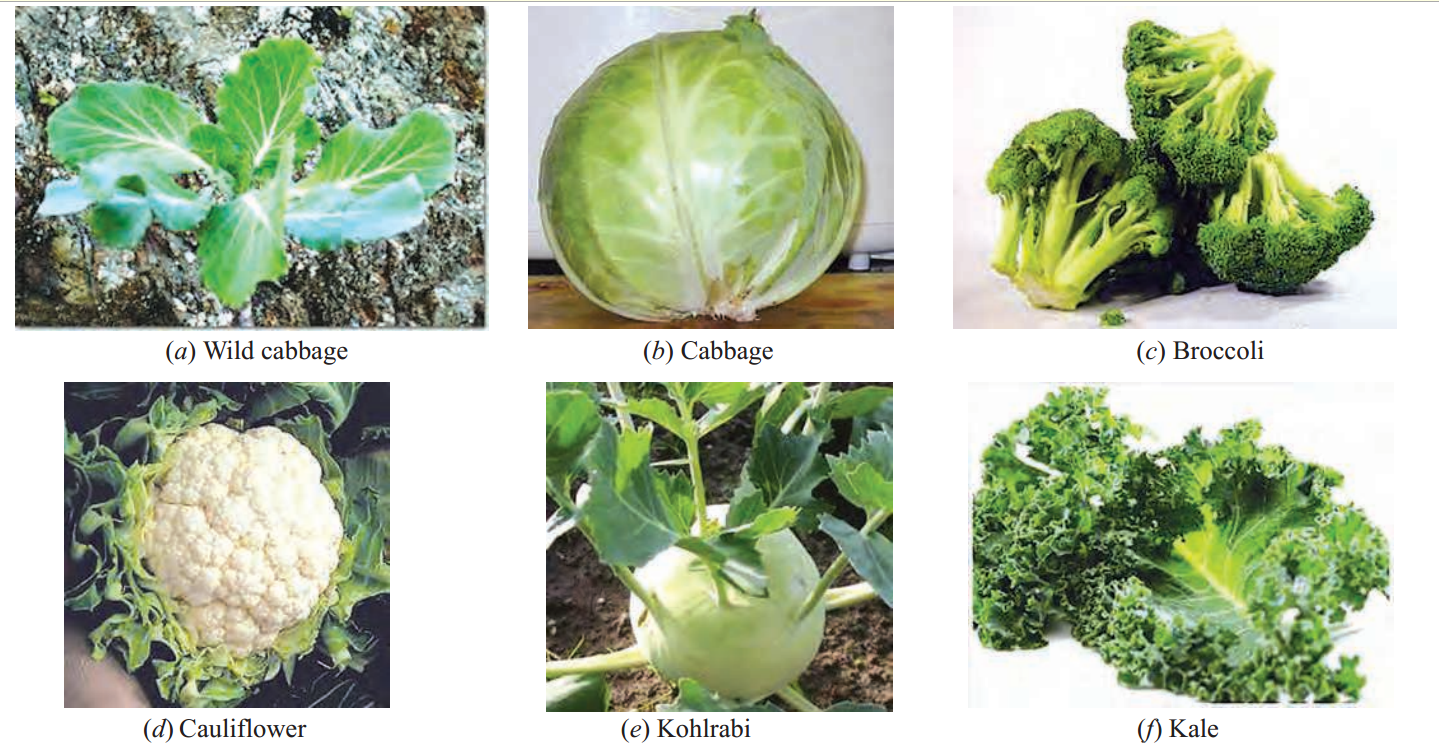
- Some farmers wanted to have very short distances between the leaves of wild cabbage and produced the common variety of ‘cabbage’.
- When farmers opted for the arrested flower development of wild cabbage plant, it led to the production of another variety of cabbage called ‘broccoli’.
- Some farmers went in for sterile flowers of wild cabbage and developed another variety of cabbage called ‘cauliflower’.
- When farmers opted for the swollen parts of wild cabbage, it led to the evolution of a yet another variety of cabbage called ‘kohlrabi’.
- And finally, the farmers wanted to grow large leaves of wild cabbage and ended up producing a leafy vegetable called ‘kale’ which is also a variety of wild cabbage.
Evolution Should Not be Equated With Progress
There is no real progress in the concept of evolution. Evolution is just the production of diversity of life forms and shaping of this diversity by the environmental selection. The only progress in evolution appears to be that more and more complex body designs of organisms have emerged over the ages.
“Karnataka SSLC Class 10 Biology Chapter 4 notes”
This will become clear from the following examples. When a new species is formed, it is not necessary that the old species will disappear (or get eliminated) from earth. It will all depend on the environment. Also it is not as if the newly formed species are in any
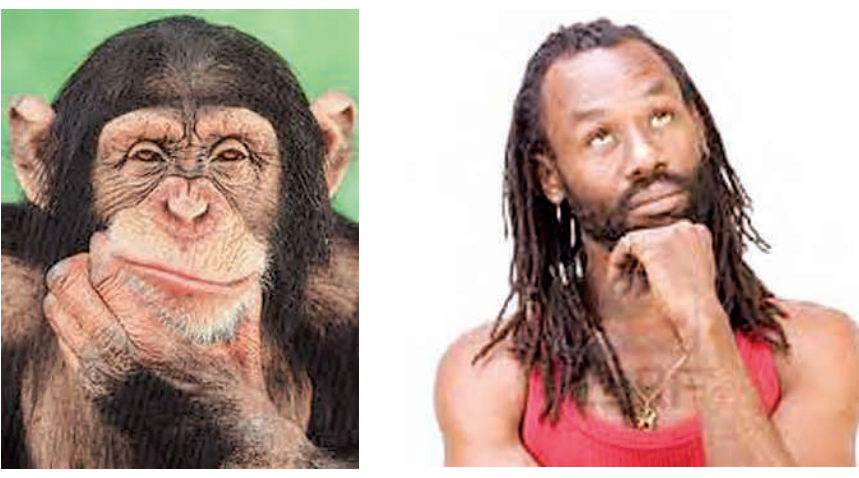
way better than the older ones. It is simply that genetic drift and natural selection processes have combined to form a population having different body design which cannot interbreed
with the older population.
It is a common belief that chimpanzees are the ancestors of human beings. It is, however, not true that human beings have evolved from chimpanzees. Actually, both chimpanzees and human beings had a common ancestor long time ago. The two offsprings of that ancestor evolved in their own separate ways to form the modern day chimpanzees and human beings.
Again, it is not as if the body designs of older organisms were inefficient. This is because many of the older and simpler forms of organisms still survive on earth. For example, one of the simplest and primitive life forms called ‘bacteria’ still inhabit some of the most inhospitable (or unfavourable) habitats such as hot springs, deep-sea thermal vents and the ice in Antarctica. Most other organisms cannot survive in such harsh environments.
KSEEB Class 10 SSLC Biology Chapter 4 Heredity and Evolution Human Evolution
Human evolution has been studied by using the various tools of tracing evolutionary relationships like excavating (digging earth), carbon-dating, studying fossils and determining DNA sequences. There is so much diversity of human body and features on the earth that for a long time people used to talk about different ‘races’ of human beings. The human races were even identified on the basis of their skin colour and named as white, black, yellow or brown.
It is now known that the so called human races have not evolved differently. In fact, there is no biological basis for dividing human beings into different ‘races’. All human beings (whether, white, black, yellow or brown) are a single species (called Homo sapiens). It has now been established by research that the earliest members of the human species (Homo sapiens) came from Africa.
“SSLC Class 10 Heredity and Evolution chapter key points”
So, irrespective of where we have lived for the past few thousand years, we all come from Africa. In other words, our genetic footprints tell us that we have African roots. About hundred thousand years ago, some of our ancestors left Africa while others stayed back. Those who left Africa slowly spread across the whole earth.
Mendel’s experiments tell us the mode of inheritance of traits from one generation to the next and Darwin’s theory of evolution tells us how organisms develop from simple to more complex forms. But neither tells us anything about how life originated on earth (or began on earth). We will now discuss the origin of life on earth briefly.
KSEEB Class 10 SSLC Biology Chapter 4 Heredity and Evolution Origin of Life on Earth
A British scientist J.B.S. Haldane suggested in 1929 that life must have developed from the simple inorganic molecules (such as methane, ammonia, hydrogen sulphide, etc.) which were present on the earth

soon after it was formed. He said that the conditions on earth at that time (including frequent lightning) could have converted simple inorganic molecules into complex organic molecules which were necessary for life. These complex organic molecules must have joined together to form first primitive living organisms. Haldane also suggested from theoretical considerations that life (or living organisms) originated in the sea water.
“Comprehensive Heredity and Evolution notes for SSLC”
The theory of origin of life on earth proposed by Haldane was confirmed by experiments conducted by Stanley L. Miller and Harold C. Urey in 1953. They assembled an apparatus to create an early earth atmosphere which was supposed to consist of gases like methane, ammonia and hydrogen sulphide, etc., (but no oxygen), over water. This was maintained at a temperature just below 100°C and electric sparks were then passed through the mixture of gases (to simulate lightning) for about one week.
At the end of one week, it was found that about 15 per cent of carbon (from methane) had been converted into simple compounds of carbon including ‘amino acids’ which make up protein molecules found in living organisms. This experiment provides the evidence that the life originated from inanimate matter (or lifeless matter) like inorganic molecules.
KSEEB SSLC Class 10 Social Science Notes History
- Chapter 1 Advent of Europeans to India Notes
- Chapter 2 The Extension of the British Rule Notes
- Chapter 3 The Impact of British Rule in India Notes
- Chapter 4 Opposition to British Rule in Karnataka Notes
- Chapter 5 Social and Religious Reformation Movements Notes
- Chapter 6 The First War of Indian Independence (1857) Notes
- Chapter 7 Freedom Movement Notes
- Chapter 8 Era of Gandhi and National Movement Notes
- Chapter 9 Post Independent India Notes
- Chapter 10 The Political Developments of 20th Century Notes
KSEEB SSLC Class 10 Social Science Notes Political Science
- Chapter 1 The Problems of India and their Notes
- Chapter 2 Indian Foreign Policy Notes
- Chapter 3 India’s Relationship with Other Countries Notes
- Chapter 4 Global Problems and India’s Role Notes
- Chapter 5 International Institutions Notes
KSEEB SSLC Class 10 Social Science Notes Sociology
- Chapter 1 Social Stratification Notes
- Chapter 2 Labour Notes
- Chapter 3 Social Movements Notes
- Chapter 4 Social Problems Notes
KSEEB SSLC Class 10 Social Science Notes Geography
- Chapter 1 Indian Position and Extension Notes
- Chapter 2 Indian Physiography Notes
- Chapter 3 Indian Climate Notes
- Chapter 4 Indian Soils Notes
- Chapter 5 Indian Forest Resources Notes
- Chapter 6 Indian Water Resources Notes
- Chapter 7 Indian Land Resources Notes
- Chapter 8 Indian Mineral & Power Resources Notes
- Chapter 9 Indian Transport and Communication Notes
- Chapter 10 Indian Industries Notes
- Chapter 11 Indian Natural Disasters Notes
- Chapter 12 Indian Population Notes
KSEEB SSLC Class 10 Social Science Notes Economics
- Chapter 1 Development Notes
- Chapter 2 Rural Development Notes
- Chapter 3 Money and Credit Notes
- Chapter 4 Public Finance and Budget Notes
